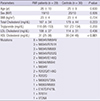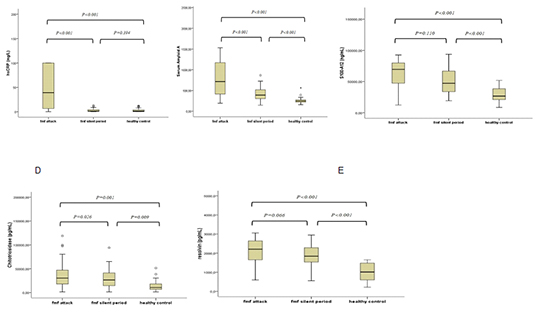1. Lee CG, Lim YJ, Kang HW, Kim JH, Lee JK, Koh MS, Lee JH, Huh HJ, Lee SH. A case of recurrent abdominal pain with fever and urticarial eruption. Korean J Gastroenterol. 2014; 64:40–44.
2. Lim AL, Jang HJ, Han JW, Song YK, Song WJ, Woo HJ, Jung YO, Kae SH, Lee J. Familial Mediterranean fever: the first adult case in Korea. J Korean Med Sci. 2012; 27:1424–1427.
3. Koo KY, Park SJ, Wang JY, Shin JI, Jeong HJ, Lim BJ, Lee JS. The first case of familial Mediterranean fever associated with renal amyloidosis in Korea. Yonsei Med J. 2012; 53:454–458.
4. Ben-Zvi I, Livneh A. Chronic inflammation in FMF: markers, risk factors, outcomes and therapy. Nat Rev Rheumatol. 2011; 7:105–112.
5. Ozen S, Uckan D, Baskin E, Besbas N, Okur H, Saatci U, Bakkaloglu A. Increased neutrophil apoptosis during attacks of familial Mediterranean fever. Clin Exp Rheumatol. 2001; 19:S68–S71.
6. Sevoyan MK, Sarkisian TF, Beglaryan AA, Shahsuvaryan GR, Armenian HK. Prevention of amyloidosis in familial Mediterranean fever with colchicine: a case-control study in Armenia. Med Princ Pract. 2009; 18:441–446.
7. Yüksel S, Ayvazyan L, Gasparyan AY. Familial mediterranean Fever as an emerging clinical model of atherogenesis associated with low-grade inflammation. Open Cardiovasc Med J. 2010; 4:51–56.
8. Duzova A, Bakkaloglu A, Besbas N, Topaloglu R, Ozen S, Ozaltin F, Bassoy Y, Yilmaz E. Role of A-SAA in monitoring subclinical inflammation and in colchicine dosage in familial Mediterranean fever. Clin Exp Rheumatol. 2003; 21:509–514.
9. Yalçinkaya F, Cakar N, Acar B, Tutar E, Güriz H, Elhan AH, Oztürk S, Kansu A, Ince E, Atalay S, et al. The value of the levels of acute phase reactants for the prediction of familial Mediterranean fever associated amyloidosis: a case control study. Rheumatol Int. 2007; 27:517–522.
10. Guzel S, Andican G, Seven A, Aslan M, Bolayirli M, Guzel EC, Hamuryudan V. Acute phase response and oxidative stress status in familial Mediterranean fever (FMF). Mod Rheumatol. 2012; 22:431–437.
11. Guo Y, He W, Boer AM, Wevers RA, de Bruijn AM, Groener JE, Hollak CE, Aerts JM, Galjaard H, van Diggelen OP. Elevated plasma chitotriosidase activity in various lysosomal storage disorders. J Inherit Metab Dis. 1995; 18:717–722.
12. Harlander M, Salobir B, Zupančič M, Dolenšek M, Bavčar Vodovnik T, Terčelj M. Serial chitotriosidase measurements in sarcoidosis--two to five year follow-up study. Respir Med. 2014; 108:775–782.
13. Kallinich T, Wittkowski H, Keitzer R, Roth J, Foell D. Neutrophil-derived S100A12 as novel biomarker of inflammation in familial Mediterranean fever. Ann Rheum Dis. 2010; 69:677–682.
14. Wittkowski H, Frosch M, Wulffraat N, Goldbach-Mansky R, Kallinich T, Kuemmerle-Deschner J, Frühwald MC, Dassmann S, Pham TH, Roth J, et al. S100A12 is a novel molecular marker differentiating systemic-onset juvenile idiopathic arthritis from other causes of fever of unknown origin. Arthritis Rheum. 2008; 58:3924–3931.
15. Monk JM, Turk HF, Fan YY, Callaway E, Weeks B, Yang P, McMurray DN, Chapkin RS. Antagonizing arachidonic acid-derived eicosanoids reduces inflammatory Th17 and Th1 cell-mediated inflammation and colitis severity. Mediators Inflamm. 2014; 2014:917149.
16. Martin CR, Blanco PG, Keach JC, Petz JL, Zaman MM, Bhaskar KR, Cluette-Brown JE, Gautam S, Sheth S, Afdhal NH, et al. The safety and efficacy of oral docosahexaenoic acid supplementation for the treatment of primary sclerosing cholangitis - a pilot study. Aliment Pharmacol Ther. 2012; 35:255–265.
17. Livneh A, Langevitz P, Zemer D, Zaks N, Kees S, Lidar T, Migdal A, Padeh S, Pras M. Criteria for the diagnosis of familial Mediterranean fever. Arthritis Rheum. 1997; 40:1879–1885.
18. Gerss J, Roth J, Holzinger D, Ruperto N, Wittkowski H, Frosch M, Wulffraat N, Wedderburn L, Stanevicha V, Mihaylova D, et al. Paediatric Rheumatology International Trials Organization (PRINTO). Phagocyte-specific S100 proteins and high-sensitivity C reactive protein as biomarkers for a risk-adapted treatment to maintain remission in juvenile idiopathic arthritis: a comparative study. Ann Rheum Dis. 2012; 71:1991–1997.
19. Serhan CN, Chiang N. Endogenous pro-resolving and anti-inflammatory lipid mediators: a new pharmacologic genus. Br J Pharmacol. 2008; 153:S200–S215.
20. Serhan CN. Novel omega -- 3-derived local mediators in anti-inflammation and resolution. Pharmacol Ther. 2005; 105:7–21.
21. Krishnamoorthy S, Recchiuti A, Chiang N, Yacoubian S, Lee CH, Yang R, Petasis NA, Serhan CN. Resolvin D1 binds human phagocytes with evidence for proresolving receptors. Proc Natl Acad Sci U S A. 2010; 107:1660–1665.
22. Recchiuti A, Codagnone M, Pierdomenico AM, Rossi C, Mari VC, Cianci E, Simiele F, Gatta V, Romano M. Immunoresolving actions of oral resolvin D1 include selective regulation of the transcription machinery in resolution-phase mouse macrophages. FASEB J. 2014; 28:3090–3102.







 PDF
PDF ePub
ePub Citation
Citation Print
Print




 XML Download
XML Download